First, what is a sink aerator and why have it? As explained in detail on wikipedia, a sink aerator is the wire mesh cap that typically is screwed onto the end of the faucet. It’s main purposes are to reduce splashing, create a more uniform stream, reduce water usage, and increase the water pressure (yes – it increases the pressure while reducing the amount of water used). Here’s a basic picture of the typical aerators:
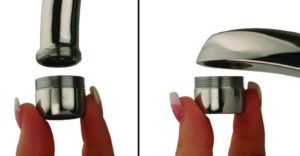
It is usually a fairly simple and straightforward process to unscrew the aerator and clean it. Sometimes you can just rinse it out, but other times you may need to soak it in something like vinegar overnight to break up more significant deposits.
But what do you do when you can’t figure out how to remove the aerator? That was my problem the other night. If you can find the model for the faucet, you can probably find information on how to remove the aerator.
In my case, I initially did a bunch of google searches similar to “round bathroom faucet with single lever”. I found some similar looking images, but the examples I found all had obvious ways to remove the aerator. Which wasn’t helpful. Here’s a picture of my faucet:
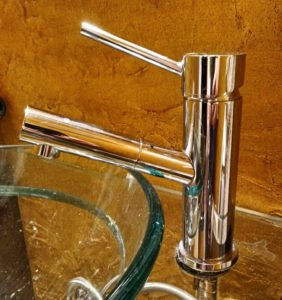
I also did google searches for “how to remove aerator” and got pages with the obvious solutions but also some good suggestions for faucets different from mine. Apparently some aerators, called cached aerators, recessed aerators, or hidden aerators require a special tool, called a cache aerator key, to remove the aerator. You can order aerator keys online for around $10 for a set to match most common sizes.
A few places I looked said that there should be a way to remove the aerator, and now I think that advice is pretty solid. Looking at my faucet, I noticed there was a seam where it looked like I could pull off the shaft of the faucet. It was a little lose and I could rotate it at that seam, and I saw there was a small Allen wrench set-screw in the hole:
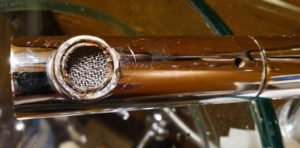
I loosened the set screw and tried to pull off the shaft. It wouldn’t move until I used quite a bit of force. Finally, I was able to pull it off. I then soaked the entire thing in white vinegar for a few hours, scrubbed it vigorously with an old toothbrush, and then put it back on. Unfortunately, it did not seem to make much difference. I pulled it off again and looked more closely if there was a way to remove the aerator. It turns out there are some flat spots on the tip that I couldn’t see while the faucet was still in one piece. I was able to use a wrench to easily unscrew the tip with the aerator out of the shaft. In this photo, you can see the flat spots to allow the piece to be unscrewed:
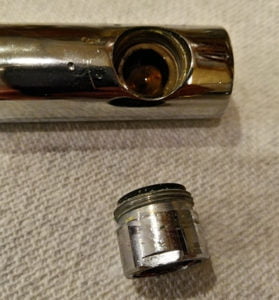
I had to further disassemble the aerator part in order to really get it cleaned. There was a rubber washer that I could pull out and then I was able to get a good look at why the water wasn’t flowing smoothly:
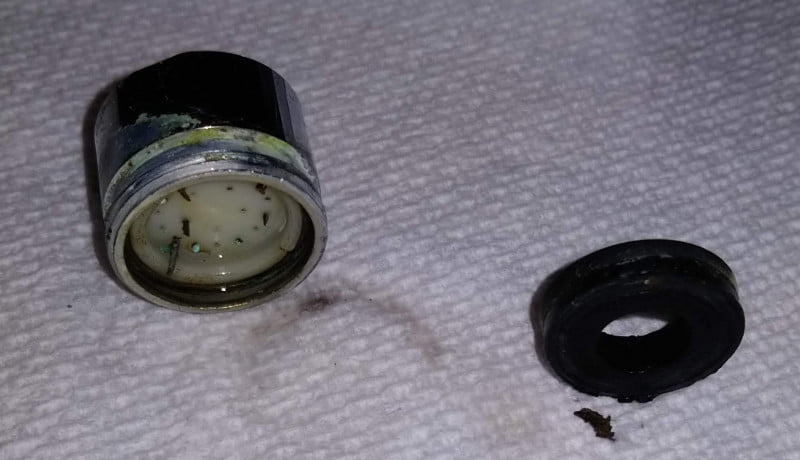
I saw these small black shards of metal stuck in a bunch of the holes. I’m guessing this was debris from when the hot water heater got replaced. Once I got it taken apart like this, I was able to clean it out easily and once replaced, it was back to working properly again.
So, bottom line if you can’t find a way to remove the aerator – there is almost definitely a way to to do so, you just have to really look.
Unrelated, it was interesting how a slight change in search terms helped me find what looks to be my faucet. Instead of searching for “round” bathroom faucet, if I changed the search to “cylinder” bathroom faucet, I found one that looks just like mine:
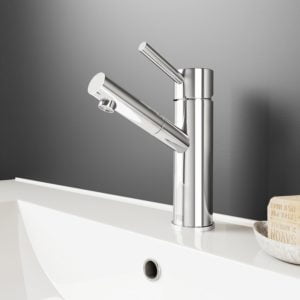
I’m not 100% sure that is the same faucet, but once I found the manufacturer, I decided perhaps it was time for me to see if I can figure out how to fix the drain in this sink, as I figured it was all made by the same company.